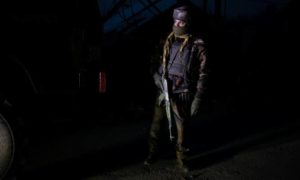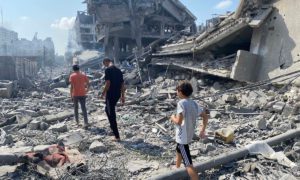Despite dictating over the local labour market, the non-local workforce often faces a ‘reality check’ in the conflict zone. During the anti-India flare-up, they remained at the crossroads in the Kashmiri society, where they’ve long established themselves as the most preferable and productive labour resource.
As a young widow in her late twenties, Sara looks like a worn-down person. She keeps shuttling between her birthplace West Bengal and Kashmir along with her two kids. Some eight years ago, while on an annual winter visit to her parents’ home, she lost her husband in a train accident. Since then, her life revolves around her son and daughter.
She doesn’t live far from the restive Nowhatta which is known to host the weekly anti-India protests. The masked youth can often be heard hurling slurs at the Indian troops in a collective outburst: “Chalo Bihari, Karo Tayari” (Get ready to leave Kashmir, Biharis.)
Many Kashmiris tend to refer every Indian armed force, and non-locals working in the valley, as Biharis.
A few years ago, as the masses were chanting the same slogan on the streets of Srinagar, Sara’s barely five-year-old kid with a prominent Bengali face rushed inside his father’s rundown house, hugged his mother and broke down.
“I was shocked when he told me how a local grocer berated him saying, ‘Oye Bihari karo tayari’,” Sara looking years older than her actual age says.
“Kids are kids,” the young widow continues. “I could feel how heartbroken he was that day. I had to console the poor thing. Although he’s still too young to understand things, he took it very seriously. He couldn’t help thinking that he isn’t one of those kids in the neighbourhood. This is the reason why he doesn’t mingle with them.”
But as one swallow doesn’t make a summer, Sara speaks of a content life she’s leading with the support of her neighbours.
“It’s not always that my son comes crying to me,” Sara says. “He’s loved by many in the locality. In fact, people took care of us when we ran out of ration. But yes, when situation turns volatile, certain abhorrent things are bound to happen.”

Even locals find themselves at the receiving end whenever anti-India tempers run high in a politically-charged place like Kashmir.
During the 2016 uprising, for instance, even cops and unionists faced a boycott-like situation from the larger defiant society.
But despite all these instants, many non-locals, especially Indian Muslims grappling with Gau Rakshaks back home feel more secure and welcome in Kashmir.
ALSO READ: Bengali Muslims in Kashmir and their ‘joy’ in the war-torn mountains
In Srinagar’s Batamaloo, some households often wake up to the calls of “Gudi, Gudi,” in the mornings.
The caller is Jafar, a non-local trader in his 50s, who speaks fluent Urdu, wears white Khan Dresses and sports a typical white skull cap.
Coming from Lucknow, Jafar calls little Kashmiri girls popping out their heads from windows or doors as “Guddi” and blesses them.
Some 25 years back, he first came to Kashmir as a young trader. While many non-locals who came with him have long left the valley, Jafar stays put—despite the volatile situation regularly testing him.
During the 2008 Amarnath land row, the windows of his room remained shut for months. As some aggressive slogans—like ‘Polish, Polish, Black Polish’—were raised against Indian forces and establishment, many non-local labourers felt uneasy.
Even as the young boys pitched the slogan to pester the Indian armed forces, it sent wrong signals around. Sharing the same Indian traits, the non-local workforce apparently had a reality check for working in the world’s oldest conflict zone.

“But their colour never really matters to us,” says Raja Begum, owner of the house Jafar lives in. “The boys would call out those names to irritate the CRPF. Many were killed in those days. That was probably the most non-violent way to express the anger. I would often wonder how Jafar would feel about it. But the gentleman remained tight-lipped about it, as if nothing had happened.”
Many see that ‘calculative silence’ as an art of survival in the place known to make it very hard for outsiders.
But despite that, many non-local labourers—tailors, masons, carpenters, cobblers, mechanics, barbers and farmers—have managed to overtake the local job market for manual labour. The preference to opt for a non-local labourer has increased as they’re being perceived to be more skilled and diligent.
“Above all, they’re willing to work hard and do not find any job menial,” says Farooq Ahmad, a local labourer. “That’s what has made them survive in this conflict zone.”
As locals grapple with unemployment, and sometimes throng police recruitment drives, many non-locals say that they have found a economically viable place which is quite contrary to the everyday experiences of the natives.
Like this story? Producing quality journalism costs. Make a Donation & help keep our work going.








